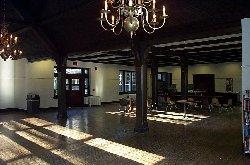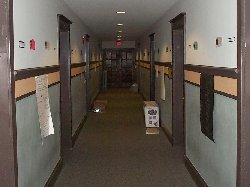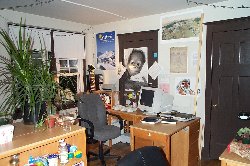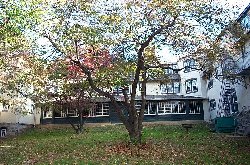

 |
The Mary Lyon Buildings |
|
Photos of the School | Photos of ML 4 | Mary Lyon School Viewbook Photos The current dormitory at Swarthmore College known as Mary Lyon is just one of five different buildings that were originally part of a girls' boarding school. Mary Lyon Building 1 is still owned by Swarthmore and is currently used as faculty housing. Mary Lyon 2 & 3 were being used as storage when ML 2 burned down in 1982; ML 3 was torn down shortly afterwards. ML 4 is the dorm commonly known as Mary Lyon, and ML 5 still stands and is presumably owned by the college. When Swat was first founded it included a college prep section; after this was discontinued in 1892 the Swarthmore Grammar School (the Prep School, what would later become PPR) was founded.1 In 1913, when the Preps went from co-ed to all-boys because of a perceived inability to attract female students, two of the teachers working there - Hadly Miller Crist and his wife Frances Leavitt Crist - left and founded the Mary Lyon School.1 The boarding school took its name, Mary Lyon, from a prominent 19th century female educator who founded Mount Holyoke College in 1837. They operated out of the Strath Haven Inn for the first year and then purchased three buildings on Harvard Avenue: ML 1 (Wildcliff), 3 (Seven Gables), and 5 (Hillcrest). ML 4 (Mary Leavitt) and ML 2 (Miller Crist) were constructed in 1918 and 1921, respectively.1 Until 1918, the Mary Lyon School just had grades 1-82; the completion of ML 4 expanded the school to a junior college.3 In 1930 the school built a golf course on the other side of the Crum Creek2, in May 1931 the PPR Prep school closed4, and in 1932 the Mary Lyon School discontinued grades 1-8.3 At some point in time it also seems that ML expanded its education to the college level, as there is a note in one of the articles that students at Wildcliff were 17-21 years old.5 The school, while it had no official religious denomination, was "emphatically Christian" and taught social formalities and sports along with regular academic studies.1 All of the students had to participate in the school's extracurricular activities.1 In January 1943 Frances Miller Crist leased the school's buildings to the Navy so they could be used as a rehabilitation center1; the school's staff and students moved to New York to finish the spring semester, then closed at the end of the academic year.6 Just before the school closed, it had an enrollment of 80-85 girls (down from a previous maximum enrollment of 150 students) about 20 full-time faculty, comprised 10 acres and reportedly 5 buildings, and had graduated about 1300 students.2 The civilian female population of Swarthmore first 'discovered' the sailors in Mary Lyon on March 5, 1943. A March 23, 1943 Phoenix article described one of Swat's first encounters with ML: After a ten-block trek through the vill, they finally arrived to find no subdued and darkened hospital, but a building whose windows blazed with lights and sailors who greeted them in the traditional manner.7 (full text of article) During the 38 months that the Navy ran the hospital, 3000 patients were treated and "extensive alterations to the original school buildings were made" to accommodate the Navy.6 After World War II the property was returned to the Crists, but as they no longer had any school to run, they sold the land and buildings to Swarthmore College in July 1946.6 The college immediately converted it, Roberts Hall, and Hall Gymnasium into dorm space for the flood of veterans returning from service.8 The Phoenix reported that the Mary Lyon buildings had enough space to house 107 students, "with married veterans and faculty also occupying a total of 19 apartments there.8" The dining hall in Mary Lyon 4 was renovated to seat 150, and breakfast was first served there on Wednesday, October 16, 1946.8 The college first used the buildings for the overflow of veterans returning from the war, but by 1952 ML 4 had been converted to half-student, half-faculty housing.3 Wildcliff (ML 1) was always faculty housing, and remains that to this very day.3 In the 1960's the ML dorms were considered to be an upperclassmen's dorm and were de facto exempt from the social norms that governed the rest of the campus; it was said that it served as a "safety valve" for social tensions in the late 60's and early 70's.3 In 1966, as the plans for Dana Hall were being finalized, a model room for the new dorm was shown in ML 2.9 At that time both ML 3 and ML 4 were being used as student dorms. An editorial in the March 8, 1966 Phoenix says that ML 4, "with its more self-sufficient rooms and traditional atmosphere, tends slightly more toward the off-campus side," while "Ashton and ML 3 provide for an even more atomized dorm life..."9 In September 1970 ML 4 became the first Swat dorm to be completely coed by room.3 In February 1981, the Board of Managers gave the administration permission to destroy ML 2 and ML 3.10 At 12:50 on the early morning of March 26, 1982, a Public Safety officer saw smoke rising through the roof of ML 2.10 At 1 a.m. the fire broke through the roof, and it wasn't until 3:52 a.m. that the fire department finally extinguished the flames.10 The fire began on the second floor of the three-story building at least an hour before it was first discovered; the building was completely unsalvageable.10 The smoke from the fire could be smelled nearly a mile away in Wharton, and the flames were visible from the fifth floor of Parrish.10 Residents in ML 4 were awakened in the night when fire trucks parked right outside the dorm; at least one resident panicked and thought that ML4 itself was on fire.11 After college netted $1.3 million in insurance from the fire3, Seven Gables (ML 3), which was to be vacated anyway in favor of the newly constructed Mertz, was also torn down. As an interesting side note, all of the lawn chairs kept on Parrish beach were destroyed in the ML 2 fire.13 In 1986 a group of ML residents made a short movie entitled "Star Trek: The ML Movie." The film chronicles one adventure of the USS Enterprise (ML) as it attempts to rescue a crewmember that has been captured by the Klingons and held hostage in Willets. Though the sound and video quality of the movie is incredibly poor, there are still a few good jokes that can be made out over the static. The movie used to be available in McCabe for people to check out, but disappeared over the summer of 2000. In summary: ML 1 - Wildcliff - originally a dorm that also had classrooms. Currently used as faculty housing. Full text of the Phoenix article from March 26, 1943:
"Oh, nothing much happened to me - I was adrift about six days after my ship went down, and then I had pneumonia, bronchitis, tonsilitis, and measles all at once. But I'm fine now - want to dance?" The twenty-some Swarthmore girls who went to entertain convalescent sailors at Mary Lyon's learned a lot about the indomitable spirit of the Navy on that first Friday night, March 5.Sources: 1 - The Swarthmorean, Mary Lyon Folder 2 in Friends Historical Library 2 - Mt. Holyoke College history collection, Folder 2, FHL 3 - Swarthmore Alumni Bulletin, March 1981, 2nd draft of an article by Paul Carnahan, Folder 2, FHL 4 - Gates to Swarthmore, Folder 2, FHL 5 - Handbook of Private Schools, 1927-28, Folder 2, FHL 6 - ML article, Folder 1, FHL 7 - The Phoenix, March 23, 1943 8 - The Phoenix, October 9, 1946 9 - The Phoenix, March 8, 1966 10 - The Phoenix, March 26, 1982 11 - The Phoenix, April 16, 1982 12 - The Phoenix, September 17, 1982 13 - The Phoenix, September 24, 1982
|
 The Mary Lyon Breakfast Room |
 A typical hallway in Mary Lyon |
|
 A Mary Lyon dorm room |
|
 Mary Lyon |
absolut swarthmore
last updated